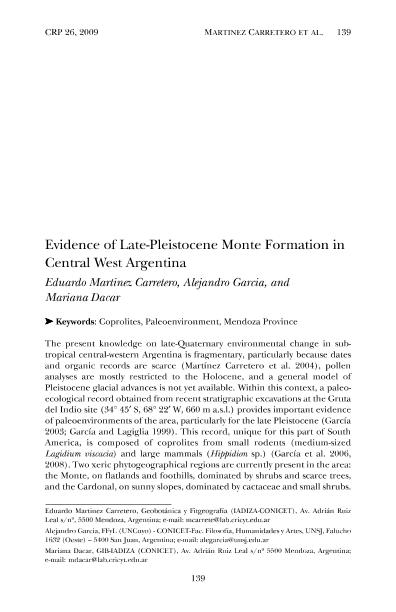Artículo
Evidence of Late-Pleistocene monte formation in central west Argentina
Fecha de publicación:
10/2009
Editorial:
Center for the Study of the First Americans
Revista:
Current Research in the Pleistocene
ISSN:
8755-898X
Idioma:
Inglés
Tipo de recurso:
Artículo publicado
Clasificación temática:
Resumen
The present knowledge on late-Quaternary environmental change in subtropical central-western Argentina is fragmentary, particularly because dates and organic records are scarce (Martínez Carretero et al. 2004), pollen analyses are mostly restricted to the Holocene, and a general model of Pleistocene glacial advances is not yet available. Within this context, a paleoecological record obtained from recent stratigraphic excavations at the Gruta del Indio site (34° 45′ S, 68° 22′ W, 660 m a.s.l.) provides important evidence of paleoenvironments of the area, particularly for the late Pleistocene (García 2003; García and Lagiglia 1999). This record, unique for this part of South America, is composed of coprolites from small rodents (medium-sized Lagidium viscacia) and large mammals (Hippidion sp.) (García et al. 2006, 2008). Two xeric phytogeographical regions are currently present in the area: the Monte, on flatlands and foothills, dominated by shrubs and scarce trees, and the Cardonal, on sunny slopes, dominated by cactaceae and small shrubs.
Palabras clave:
Coprolites
,
Paleoenvironment
,
Hippidion
,
Microhistolog¨ªa
Archivos asociados
Licencia
Identificadores
Colecciones
Articulos(CCT - SAN JUAN)
Articulos de CENTRO CIENTIFICO TECNOLOGICO CONICET - SAN JUAN
Articulos de CENTRO CIENTIFICO TECNOLOGICO CONICET - SAN JUAN
Articulos(IADIZA)
Articulos de INST. ARG DE INVEST. DE LAS ZONAS ARIDAS
Articulos de INST. ARG DE INVEST. DE LAS ZONAS ARIDAS
Citación
Martinez Carretero, Eduardo Enrique; García, Eduardo Alejandro; Dacar, María Ana; Evidence of Late-Pleistocene monte formation in central west Argentina; Center for the Study of the First Americans; Current Research in the Pleistocene; 26; 10-2009; 139-141
Compartir




